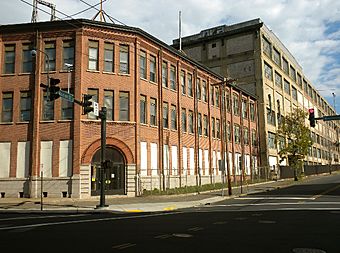Winchester Repeating Arms Company Historic District facts for kids
|
Winchester Repeating Arms Company Historic District
|
|

Front of Winchester Repeating Arms Company (1870s), 275 Winchester Ave., New Haven, Connecticut.
|
|
| Location | Roughly bounded by Sherman Pkwy., Ivy St., Mansfield St., Admiral St., and Sachem St., New Haven, Connecticut |
|---|---|
| Area | 255 acres (103 ha) |
| Built | 1912 |
| Architect | Robinson, Leoni W.; Et al. |
| Architectural style | Colonial Revival, Italianate, Queen Anne |
| NRHP reference No. | 87002552 (original) 13000898 (increase) |
Quick facts for kids Significant dates |
|
| Added to NRHP | January 28, 1988 |
| Boundary increase | April 21, 2015 |
The Winchester Repeating Arms Company Historic District is a special area in New Haven, Connecticut. It's recognized for its important history and unique buildings. This district was added to the National Register of Historic Places in 1988.
It includes many properties, about 867 in total. Most of these are homes that show how people lived long ago. The main part of the district is a large area, about 75 acres, where the old Winchester Repeating Arms Company factory used to be. This factory was very important to the neighborhoods around it.
Today, some parts of the old Winchester plant are used by Science Park at Yale. This is a place that helps new businesses grow, and it has connections with Yale University.
Contents
Why is this Place Important?
This historic district is special for a few big reasons.
A Look into History and Industry
First, it shows us a lot about the past of the Winchester Repeating Arms Company. This company was one of the most famous makers of weapons in the late 1800s and early 1900s.
Second, the district helps us understand how big factories and large neighborhoods for workers grew up together. This happened a lot in cities in the northeastern United States during that time. It shows how industry and community life were closely linked.
Amazing Architecture and Design
The district is also important for its buildings. Many of the factory buildings were designed by Leoni W. Robinson. He was a very important architect in New Haven during that period.
Around the factory, you can see many homes where workers lived. These houses show different popular building styles from that era. These styles include late Greek Revival, Italianate, Gothic Revival, Queen Anne, and Colonial Revival. They offer a glimpse into the architecture of the past.
Homes for Workers
Many homes in the district were built for one, two, or three families. These were often called "tenement buildings." They provided housing for the many people who worked at the Winchester factory.
Two people who were very successful at building these homes were Joseph Sheldon and John W. Bishop. They helped build almost all the houses on Admiral and Henry Streets. They also built many homes on Munson Street, right across from the Winchester factory.
The Rise of Winchester
The Winchester company didn't start in this location. It first began on Union Street in New Haven. Then, in 1866, it moved to Bridgeport. But in 1870, Winchester moved back to New Haven, to the spot where the historic district is now. The very first buildings they built there are no longer standing.
The company grew very quickly. By 1887, it had more than 600 employees. By the early 1900s, over 1,000 people worked there! This shows how important the factory was to the city's economy and its people.
Streets of the District
The Winchester Repeating Arms Company Historic District includes many streets. Each street has its own history and buildings that tell a story.
Mansfield Street
This street features many historic homes.
Sheffield Street
Here you can find more residential buildings and the Shelton Avenue School.
Division Street
This street also has examples of the homes built for workers.
Winchester Avenue
This avenue is central to the district. It's where the main Winchester Repeating Arms Company complex was located. You can also find other important buildings here, like the old McKesson and Robbins factory.
Munson Street
Munson Street has many homes, including those built by successful developers like Joseph Sheldon and John W. Bishop.
Thompson Street
On Thompson Street, you can see Newhall's Boarding House, which was built way back in 1860.
Ivy Street
This street is home to the Ivy Street School.
Admiral Street
Admiral Street also has many historic houses.
Dixwell Avenue
Dixwell Avenue features a variety of buildings, including homes with interesting details like decorative bargeboard.
Shelton Avenue
This street also contributes to the historic feel of the district.
Newhall Street
Newhall Street adds to the collection of historic buildings in the area.
Henry Street
Henry Street is another area where many homes were built by early developers.
Neighborhood Connections
The Winchester Repeating Arms Company Historic District is part of two neighborhoods in New Haven: Newhallville and Dixwell. The district covers most of the southern part of Newhallville and the northern part of Dixwell. This shows how the factory and its surrounding homes were deeply connected to the life of these communities.
Images for kids















